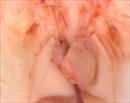Foxh1b2b2662Clo
Chemically induced Allele Detail
|
|
| Symbol: |
Foxh1b2b2662Clo |
| Name: |
forkhead box H1; Bench to Bassinet Program (B2B/CVDC), mutation 2662 Cecilia Lo |
| MGI ID: |
MGI:5615244 |
| Gene: |
Foxh1 Location: Chr15:76552425-76554148 bp, - strand Genetic Position: Chr15, 36.24 cM
|
| Alliance: |
Foxh1b2b2662Clo page
|
|
Mutant exhibits displaced outflow tracts which is diagnosed as double outlet single ventricle, right aortic arch, and aberrant right subclavian artery forming incomplete vascular ring by ECM imaging
Show the 24 phenotype image(s) involving this allele.
|

|
|
| Strain of Origin: |
C57BL/6J
|
| Project Collection: |
B2B/CvDC
|
|
| Allele Type: |
|
Chemically induced (ENU) |
| Mutation: |
|
Single point mutation
|
| |
|
Mutation details: This ENU-induced mutation was isolated in a screen at the University of Pittsburgh. The molecular lesion is an A to C substitution at coding nucleotide 1133 in exon 3 of the cDNA (c.1133A>C, NM_007989). This changes the aspartic acid residue to alanine at position 378 of the encoded protein (p.D378A).
(J:175213)
|
|
|
View phenotypes and curated references for all genotypes (concatenated display).
|
|
|
|
|
| Mouse strains and cell lines
available from the International Mouse Strain Resource
(IMSR) |
| Carrying this Mutation: |
Mouse Strains: 0 strains available
Cell Lines: 0 lines available
|
| Carrying any Foxh1 Mutation: |
34 strains or lines available
|
|
|
Summative Diagnosis:
Cardiovascular phenotypes: Complex congenital heart disease associated with heterotaxy with right isomerism. Phenotypes observed include dextrocardia/mesocardia, double outlet right ventricle (A,L,L) with anterior placement of the aorta (DORV, Taussig-Bing subtype), right atrial isomerism, unbalanced atrioventricular septal defect (AVSD), double outlet primitive single ventricle, hypoplastic left ventricle (LV).
Noncardiovascular phenotype: Visceral organ situs defects including dextrogastria, right lung isomerism, intestinal malrotation, asplenia. Also observed are hypoplastic thymus, right side diaphragmatic hernia, malaligned sternal vertebra, and craniofacial defects including anencephaly, acrania, agnathia, microstima, microcephaly, low set ears, proboscis, cylcopia, and anophthalmia.
|
 Analysis Tools
Analysis Tools




